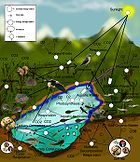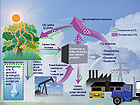- Patch dynamics
-
For the use of the term in physics, see Patch dynamics (physics).
Patch dynamics is a conceptual approach to ecosystem and habitat analysis that emphasizes dynamics of heterogeneity within a system (i.e. that each area of an ecosystem is made up of a mosaic of small 'sub-ecosystems')[citation needed].
Diverse patches of habitat created by natural disturbance regimes are seen as critical to maintenance of diversity (ecology). A habitat patch is any discrete area that is used by a species for breeding or obtaining other resources. [1] They have a definite shape and spatial configuration, or heterogeneity.
Mosaics are the patterns within landscapes that are composed of smaller elements, such as individual forest stands, shrubland patches, highways, farms, or towns.
Contents
Patches and mosaics
Historically, due to the short time scale of human observation, mosaic landscapes were perceived to be static[citation needed]. This focus centered around the idea that the status of a particular population, community, or ecosystem could be understood by studying a particular patch within a mosaic. However, this perception ignored the conditions that interact with, and connect patches. In 1979, Bormann and Likens coined the phrase shifting mosaic to describe the theory that landscapes change and fluctuate, and are in fact dynamic. This is related to the battle of cells that occurs in a Petri dish[citation needed].
Patch dynamics refers to the concept that all landscapes are dynamic[citation needed]. There are three states that a patch can exist in: potential, active, and degraded. Patches in the potential state are transformed into active patches through colonization of the patch by dispersing species arriving from other active or degrading patches. Patches are transformed from the active state to the degraded state when the patch is abandoned, and patches change from degraded to potential through a process of recovery. [2]
Logging, fire, farming, and reforestation can all contribute to the process of colonization, and can effectively change the shape of the patch. Patch dynamics also refers to changes in the structure, function, and composition of individual patches that can, for example, effect the rate of nutrient cycling[citation needed].
Patches are also linked, although separated from other patches, migration occurs from one patch to another[vague]. This migration maintains the population of some patches, and can be the mechanism by which some plant species spread. This implies that ecological systems within landscapes are open, rather than closed and isolated. (Pickett, 2006)
Conservation efforts
Recognizing the patch dynamics within a system is needed for conservation (ecology) efforts to succeed. Successful conservation includes understanding how a patch changes and predicting how they will be affected by external forces[citation needed]. These externalities include natural effects, such as land use, disturbance, restoration, and succession, and the effects of human activities. In a sense, conservation is the active maintenance of patch dynamics (Pickett, 2006).
See also
- Conservation biology
- Edge effect
- Habitat conservation
- Habitat corridor
- Habitat fragmentation
- Island biogeography
- Landscape ecology
- Spatial ecology
External links
- http://www.jstor.org/view/08888892/di995160/99p00105/1?frame=noframe&userID=a9e922ee@ucsc.edu/01cc99331100501bfbcaa&dpi=3&config=jstor
- http://72.14.253.104/search?q=cache:rQRizzAWL9MJ:www.ecostudies.org/reprints/Wright_et_al_2004_Patch_Dynamics_Oikos_105_336-348.pdf+patch+dynamics&hl=en&ct=clnk&cd=3&gl=us&client=safari
- http://ieeexplore.ieee.org/iel5/5992/30777/01425395.pdf?isnumber=&arnumber=1425395
References
- Forman, R.T.T. 1995. Land Mosaics: The Ecology of Landscapes and Regions. Cambridge University Press, Cambridge, UK.
- Groom, Martha J., Meffe, Gary K., Carroll, Ronald. 2006. Principles of Conservation Biology, Third Edition. Mosaics and Patch Dynamics by Steward T.A. Pickett
Categories:- Habitats
- Biogeography
- Landscape ecology
- Ecological restoration
- Habitat (ecology) terminology
- Biology terminology
- Environmental terminology
Wikimedia Foundation. 2010.


